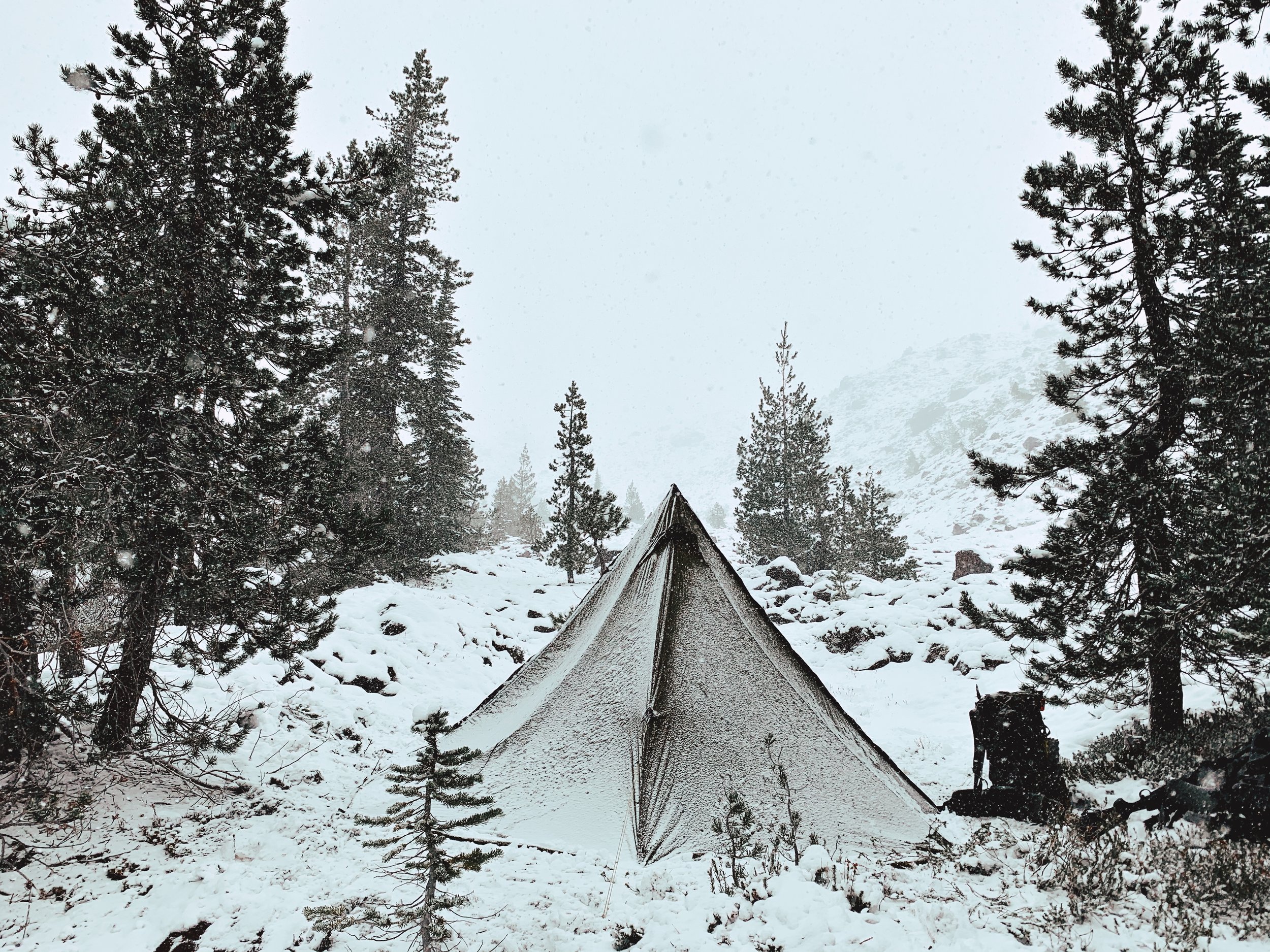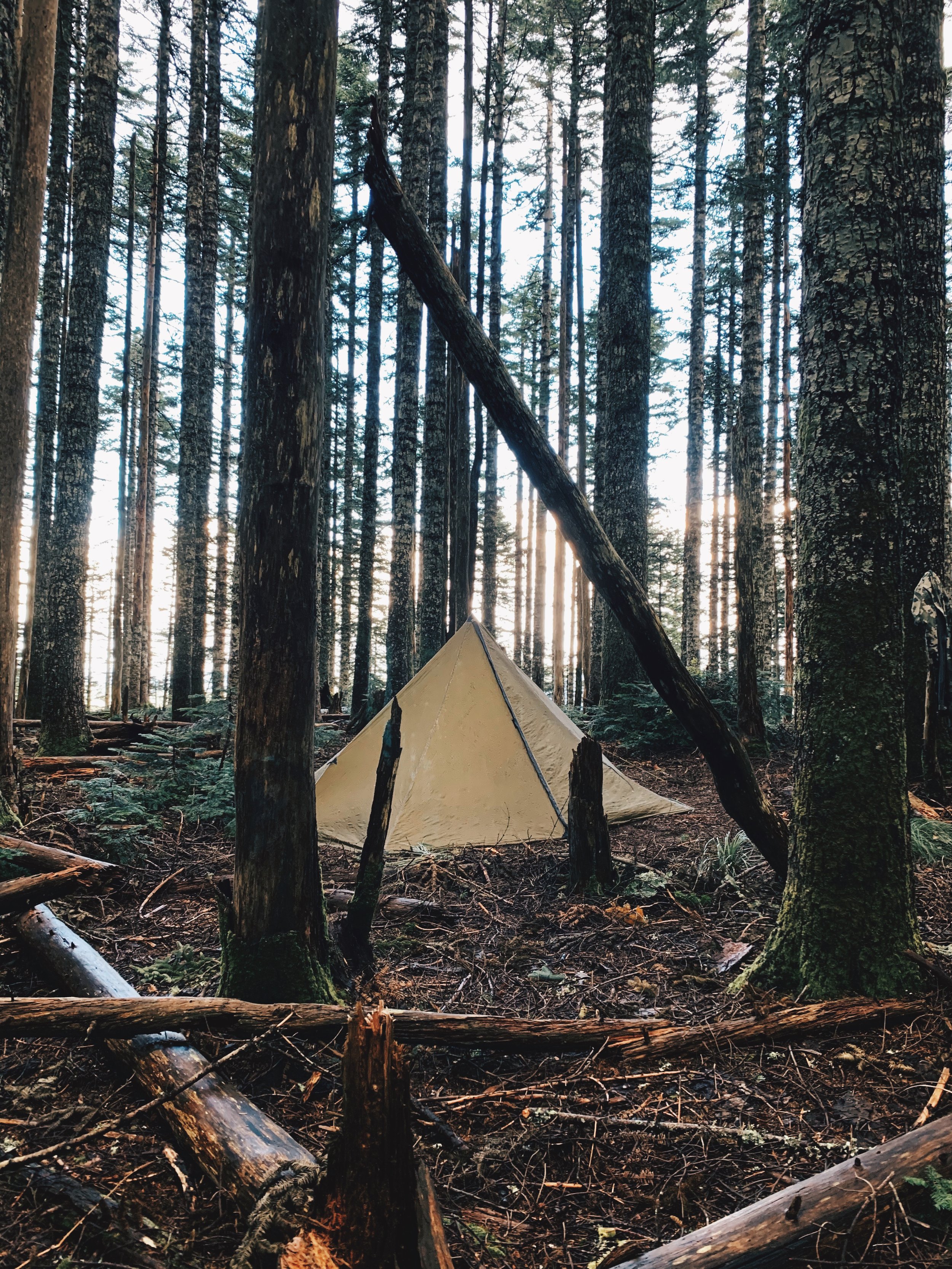Base Camps vs. Spike Camps and How To Choose Your Backpack Hunting Style
There are two main forms of backpack hunting camps; a base camp where you return to each evening and a mobile (or spike) camp which requires you to pack up each morning and make camp each night. Neither is better than the other, however, depending on how you prefer to hunt and the terrain you’re hunting in, each method will bring about its own set of challenges. It’s up to you as the hunter to determine which camp is best suited for your situation and to plan your gear accordingly.
Seek Outside Cimarron doing some work in the snow.
Backpack Hunting from a Basecamp
A Base Camp is exactly what it sounds like; it’s an established backcountry camp from which you base all of your hunting activities for the duration of your hunt. It’s common to see a base camp set in close proximity to resources like water or a trail system and centrally located to potential hunting areas. These camps are often scouted prior to the season to ensure adequate room for a camp, to ensure viability for hunting, and prepped for the coming season (think stashing of supplies like water or food).
Base Camps are likely the most common backcountry hunting camp used by backpack hunters because of how easy they are to hunt from. Once camp is initially set, it’s often there for the duration of the hunt, continually improved upon each day, and can be a solid retreat from the weather in the event it moves in. With a base camp being stationary, comfort items such as a lightweight camp chair or a lightweight wood-burning stove for floorless shelters is an easily justified piece of gear to pack in because a little extra comfort in camp can mean the difference in heading home early due to weather or staying until the last possible minute.
Below is a list of pros and cons to consider when deciding if a base camp is right for your backpack hunt.
Pros
Provides a reliable place to return to after each day’s hunt.
Often located near resources such as water or a trail system.
Can be easily scouted prior to the season to ensure viability.
Generally more suitable for larger shelters and groups of hunters.
Often established in a location that offers more protection from the elements like high winds or foul weather.
Intended to be centrally located to multiple hunting grounds.
Comfort items such as a wood-burning stove or camp chairs are justified at a base camp.
Cons
Lack of mobility can hinder hunting success if the game has moved on from the area due.
Established camps near resources could attract other hunters to the same area and create competition for the hunt.
With base camps come heavier items such as chairs and a wood-burning stove that make the pack in heavier. This also makes the ability to move camp, if needed, a longer process.
Has a limited hunting range since supplies and shelter are at one central location and must be returned to.
Backpack Hunting from a Spike Camp
For those who truly want the hunt with the wind, move with the game, and test their ability to adapt to changing conditions, a spike camp might be what you’re looking for on your backpack hunt. Spike camps are intended to be highly mobile and change each day depending on where the game is located. As opposed to hunting from a base camp, if the animal you’re hunting moves further from camp than you’re comfortable with, you don’t need to give up on it. Instead, you can continue your hunt as long as you’re willing to because your camp and supplies are always with you on your back. As long as you have enough water and food to endure the pursuit, you can hunt for as long as wish into the evening and make camp wherever you wish.
Using spike camps to hunt from requires the hunter to be extremely aware of what goes INTO their backpack. Counting ounces pays huge dividends for this type of hunting because comfort comes in the form of how your pack feels when wearing it all day versus how camp feels at night. Light and fast is the name of the game for those hunting out of spike camps and a minimalist mindset will no doubt keep you in the field longer and increase your overall success.
Below is a list of pros and cons to consider when deciding if a spike camp is right for your backpack hunt.
Pros
Highly mobile and flexible.
Provides the hunter the ability to easily adapt to changing conditions in the hunt.
Light and fast - less gear means less weight and less to do in and around camp when you finally get there.
Affords flexibility on the hunt if the game has moved on.
Ability to go further and away from crowds to hunt less pressured game.
Cons
Requires pre-season scouting, research, and intimate knowledge of where resources are located such as water.
Less comfort in camp due to minimal gear.
Requires camp to be packed up and pitched each day.
Requires the hunter to hunt with all their gear throughout the day.
This may include having to camp in less-than-ideal locations while being exposed to the elements.
The Hybrid Camp
If during your preseason scouting, you found two or three locations that could serve well as a base camp that coincides with great animal habitat, there’s always the option of planning a hybrid camp. You could start in one location and hunt it for a few days until you feel it’s time to move on and then pack up and move your camp to the second location. This could give you a nice balance of spending a few nights in the same spot so you feel like you have reliable resources while also giving you the ability to adjust on the fly if need by.
Another way to go about this hybrid method could be to have your base camp set and set out for a long day hunt where you’ll spend a night or two on a far ridge or basin and return back to your camp a day or so later. This would also give you the advantage of adapting to your environment and animal patterns. The question then becomes how do you optimize for a hybrid base/spike camp?
Depending on your specific scenarios such as terrain involved, miles needing to be covered, or weather patterns, you may want to do your best in trimming the fat off your kit and lean toward the “light and fast” category instead of the “fat and happy” one. You can offset the less-than-ideal comfort that comes along with the spike camp method by bringing that ultralight camp chair and maybe a small tarp to pitch alongside your solo tent. It’s the little things that add up to feeling comfortable in camp and it doesn’t always require a wood-burning stove.
Think outside the box about what makes YOU feel comfortable in camp and consider if it’s worth lugging along with you.
Here’s a quick set of questions to ask yourself before you put anything in your pack.
Is this a NEED or a WANT?
Wants weigh packs down quickly and take up valuable space.
If I’m only in camp to eat and sleep rather than lounge around, will this item move the needle for me substantially or can I get by without it?
Is there a lighter version of the item I want to bring that makes more sense?
If I don’t bring this item, what’s the absolute worst that could happen?
Play this one out and run through any and all possible scenarios.
Not all backcountry hunts can support moving camps every couple of days, but for those hunters willing to trim down their kit and do more hunting than lounging, this Hybrid Camp option is a great way to go.
Which Backcountry Camp Is Right for You?
There is no right or wrong way to hunt from your backpack. There are only different ways to accomplish the same goal and that is to come out of the backcountry with either a punched tag and a pack full of organic meat or an experience you’ll tell for years to come. Whether you decide to hunt from a base camp, make spike camps along the way, or do a mixture of both, it greatly depends on you as the hunter and what you see as the best method for your hunt. Those goals span the spectrum of hammering out miles and all-day glassing affairs to a more relaxed backcountry hunt focused on spending quality time with those in your camp. Both come with an optimized set of gear so choose which is best for you and plan accordingly.
Emory, By Land
Thanks for stopping by the website and checking out this article! If you have any questions for me or want to connect, you can leave a comment below or shoot me a personal message at emory@byland.co.





